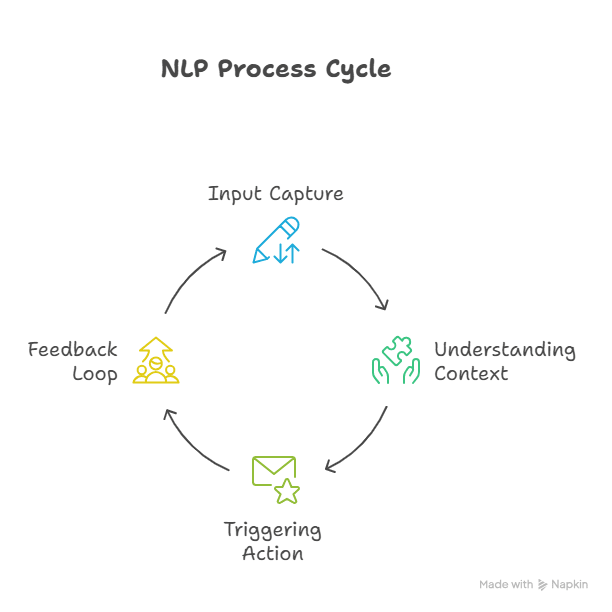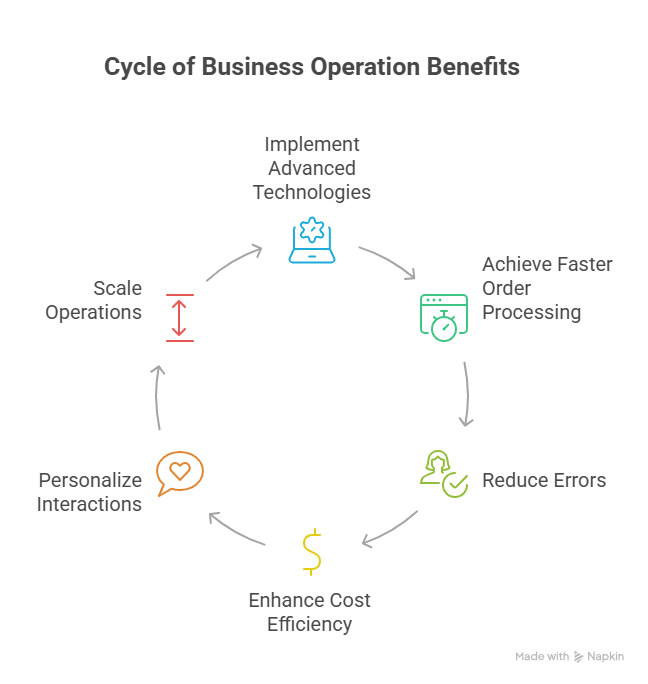
Natural Language Processing (NLP) automates your Shopify store’s order processing by listening, interpreting, and acting in real time, just like a human would. This AI-driven approach enables Shopify to understand real words — not just codes or clicks — and turn them into automated actions that save hours of repetitive work. It frees Shopify merchants from the sales-order hustle so they can focus on real growth, creativity, and a better customer experience.
Table of Contents
Introduction
If you are running a Shopify store, you know how awesome it feels when a sale notification pops up. But, the excitement quickly fades at the thought of the manual tasks it involves. From updating inventory to order processing and handling customers’ queries one by one. This is a tedious process, to be honest, that drains more effort and costs time.
That’s why more and more Shopify merchants are now turning to Natural Language Processing (NLP) automation for their sales orders. This AI branch effortlessly handles the entire sales order process, reducing your stress, streamlining customer support, and giving you more time to focus on critical growth factors. But how it automates orders in Shopify is the essence of this blog post, and we will discuss the methods in detail to understand its mechanism.
What does NLP mean, actually?
Natural Language Processing, usually called NLP, is what lets computers understand how we talk and write. Integrating NLP in your Shopify means giving it the ability to read plain sentences the way your staff would. So instead of customers filling out perfect forms or typing in code-like commands, they can just say what they mean, and the system figures it out. The system interprets intent.
For example, if someone types: “Repeat my last order but send it to the Rajkot warehouse.”
Shopify’s NLP integration identifies the intent (repeat order) and the variable (new address) and executes it automatically. This combination of action and comprehension is what makes AI Shopify development so powerful today.
Why Automating Orders with NLP Matters Now?
It’s a fact that e-commerce is increasing superfast. The projected eCommerce market volume is US$4.96 4.96tn by 2030. Stores handle multiple order channels, which include website, chat, WhatsApp, and even voice. Manual management isn’t scalable anymore, and that’s why NLP-based automation is quickly becoming essential:
Customers Don’t Speak in Code
Buyers rarely communicate in the exact structure your forms expect. They ask casually, make typos, or use shorthand. For example: “Send 2 more of the blue variant formal shirts from last week’s order.”
A standard automation rule can’t process that. But NLP order automation can extract meaning and map it to the right SKU, quantity, and action.
Shopify Stores Are Overloaded with Repetition
Whether it is confirming reorders, checking stock, sending updates, or fixing small customer errors, these tasks are all repetitive tasks that cost your time and effort. NLP-powered systems take care of all these tasks in a structured format, which gives your teams ample time to focus on strategy and growth.
Human Attention Should Be Spent Wisely
You shouldn’t waste your time on inboxes and spreadsheets. By having NLP handle routine text-based actions, you have space to focus on marketing, product improvement, and customer experience. In short, automation with understanding is more intelligent than automation by rules.
How NLP Actually Works Inside Shopify?

Let me help you understand this in a simple way: NLP automation is a layered process that connects communication, intent, and execution.
Step 1: Input Capture
A message enters your system. This can come from a chatbot, email, or customer support. NLP reads the message and figures out what the client is trying to do. They may want to reorganize, cancel, or change something.
Step 2: Understanding Context
AI analyzes the tone behind messages, their keywords, and relationships. This distinguishes between “Cancel order” and “Cancel only one item”. It also picks up references such as “same as last time” or “previous order”.
Step 3: Triggering the Right Action
Once NLP understands the request, it sends structured commands through an API or app into Shopify. That could mean editing an order, triggering a fulfillment update, or sending a confirmation message, all automatically.
Step 4: Feedback Loop
The system responds naturally, for example: “Got it! Your order’s been updated and will ship tomorrow.”
That human-like clarity is part of why Shopify NLP integration feels so seamless.
The Key Benefits of NLP Order Automation

Now that you understand the mechanics, let’s talk about why this really matters for Shopify merchants.
- Faster Order Processing: No waiting for someone to manually interpret messages. NLP turns free-text orders into immediate actions. Faster turnaround means happier customers.
- Error Reduction: Missed messages, wrong variants, or duplicate entries all shrink drastically when your system actually understands the language.
- Cost Efficiency: Automating repetitive communication tasks reduces hours spent on data entry and support backlogs. For growing stores, that’s a quiet but massive saving.
- Personalized Interactions: NLP can read tone and intent, meaning your system can respond politely, warmly, or helpfully, all while staying on-brand. That builds trust faster than canned templates ever could.
- Scalability: Whether you process 10 orders or 10,000, NLP systems scale instantly. You don’t need to retrain your team for every surge or promotion period.
How to Get Started with Shopify NLP Automation?
If you’re planning to explore NLP order automation in your Shopify store, here’s a simple roadmap:
- Identify Repetitive Workflows: Look at where most time is wasted — customer emails, change requests, or repeat orders.
- Choose the Right NLP Platform: You can pick any popular tool, such as Dialogflow, OpenAI APIs, or IBM Watson, to get started.
- Integrate with Shopify: Use custom apps or middleware for smooth data flow between NLP and your store backend.
- Test and Train: Include real customer phrases so the system learns your store’s language.
- Monitor and Improve: Keep an eye on logs, measure saved time, and tweak as you go.
If you are doing it by yourself, then we suggest you start small and scale smartly! If you choose the wisest way, it is best to hire AI developers for seamless Shopify NLP integration.
The Future of NLP in Shopify Order Management
We’re entering a time when your store won’t just respond to clicks, it will listen, learn, and adapt. Days not far when you will see customers simply messaging, “Hey, send the same order as last month but gift-wrap it this time.” And Shopify will execute it automatically.
NLP is evolving beyond text to handle voice commands, multilingual communication, and predictive workflows. Soon, you’ll see voice-based reordering or WhatsApp conversations that convert directly into invoices.
For Shopify merchants, adopting NLP now is more about staying ahead than just keeping up.
Final Thoughts
Running a Shopify store isn’t easy, with orders, messages, and customer requests never seeming to stop. That’s exactly why adding NLP is worth it. With NLP order automation, your store starts handling the small things automatically, understanding customer messages, processing changes, and sending confirmations, so your team can focus on what actually drives growth.
The best part? You don’t need to be a tech expert or run a huge operation to get started. A smart Shopify NLP integration can fit right into your existing setup and start saving time from day one.
Get in touch with Metizsoft to see how NLP can make your Shopify store faster, smarter, and easier to run, day after day.
FAQs
Can small Shopify stores afford NLP integration?
Yes. Many cloud-based NLP tools charge per request or per order, so you only pay for what you use. It’s cheaper than hiring extra staff for repetitive tasks.
Will NLP handle mistakes or unclear messages?
If the intent isn’t clear, the system can flag it for a quick human check instead of acting blindly. You stay in control while still saving time.
Do I need to know coding to add NLP to Shopify?
Not really. You can work with a Shopify developer who specializes in AI integrations. Most of the setup is handled through existing apps or simple API connections.
What’s the biggest benefit of NLP for e-commerce?
Consistency. Every order, message, and follow-up gets handled quickly and accurately, which builds trust and frees you to focus on growth.
AboutManthan Bhavsar
Related Posts
How AI is Transforming Warehouse Management: Key Use Cases and Benefits
Table of Contents SummaryIntroductionAI in Warehouse Management: Key TakeawaysBenefits of AI in WarehousingAI Use Cases for...
How is Agentic AI Evolving in Next-Gen AI Systems? Key Architecture, Models & Frameworks
Table of Contents IntroductionWhat is Agentic AI? A Quick IntroductionKey Mechanisms Behind Agentic AIUnderstanding Different...
